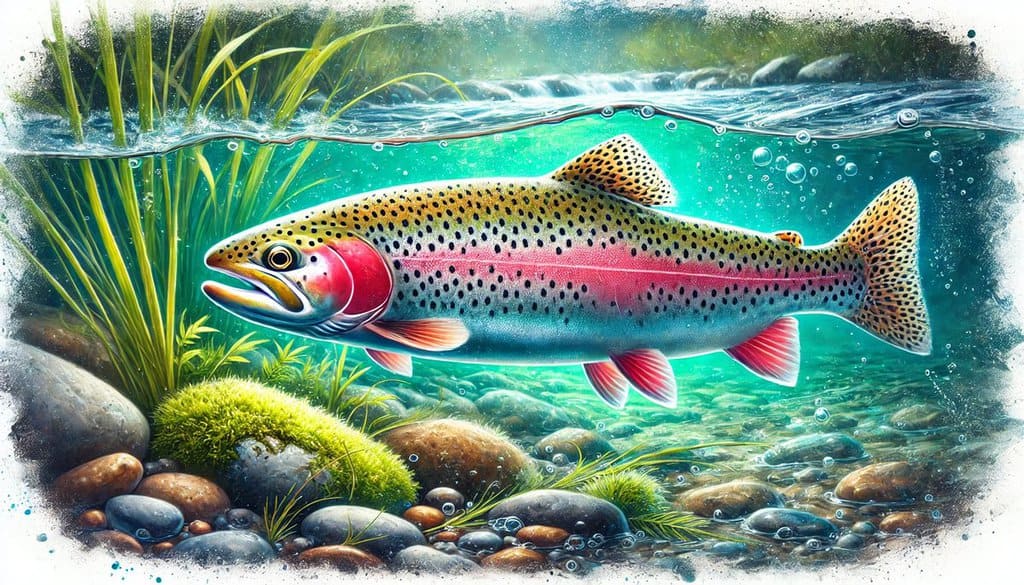Introduction
Rainbow trout (Oncorhynchus mykiss) is a popular species for aquaponics systems due to its hardiness, fast growth rate, and delicious flavor. Originally native to cold-water tributaries of the Pacific Ocean, rainbow trout has been widely introduced around the world for both sport fishing and aquaculture[1]. This species is prized for its adaptability, resilience to a range of water conditions, and impressive growth rates, making it an excellent choice for aquaponics[4].
Natural Habitat and Behavior
Rainbow trout naturally inhabit cold, clear freshwater streams and lakes. In the wild, they are known for their aggressive feeding behavior and their ability to thrive in fast-moving waters[2]. When kept in aquaponics systems, rainbow trout generally maintain a docile temperament, though they may exhibit some territorial behavior as they grow larger[4]. They are best kept in species-specific tanks due to their preference for cooler water temperatures compared to many other aquaponics fish.
Water Requirements
Rainbow trout have specific water requirements that are crucial for their health and growth:
- Temperature Range: The optimal temperature range for rainbow trout is 10-18°C (50-65°F)[4]. Temperatures above 21°C (70°F) can stress the fish and impede growth.
- pH Level: Rainbow trout thrive in a pH range of 6.5-8.0[4].
- Oxygen Levels: High dissolved oxygen levels are essential, with a minimum of 5.0-5.5 ppm required[1].
- Ammonia/Nitrate Sensitivity: Rainbow trout are sensitive to ammonia and nitrite. Levels should be kept as close to zero as possible, with nitrates below 75 mg/L[1].
Tank or Pond Setup
- Tank Size: A minimum tank size of 800 liters (200 gallons) is recommended for rainbow trout[4].
- Density: The recommended stocking density is 25-40 liters (7-10 gallons) of water for every 0,45 kg (1 lb) of fully mature fish[4].
- Filtration & Aeration: Strong filtration and aeration are crucial due to the trout’s high oxygen requirements and sensitivity to water quality[2].
Feeding Requirements
Rainbow trout are carnivorous and require a high-protein diet:
- Diet: Commercial trout pellets with 40-50% protein content are ideal[2].
- Feeding Frequency: Feed 2-3 times daily, adjusting amounts based on water temperature and fish size[2].
- Feeding Behavior: Rainbow trout are aggressive feeders and will readily accept pelleted food[3]. Will also eat any smaller siblings that fit in its mouth.
Growth and Reproduction
- Growth Rate: Rainbow trout grow rapidly, reaching marketable size (350g to 1kg) in less than a year under optimal conditions[1].
- Breeding: Breeding rainbow trout in aquaponics systems is challenging and not typically recommended. In natural settings, they spawn in spring when water temperatures rise[2].
Harvesting & Culinary Considerations
Rainbow trout are highly valued for their flavor and pink flesh. They can be prepared in various ways, including grilling, smoking, or baking. For optimal flavor, it’s recommended to fast the fish for 1-2 days before harvesting[4].
Pros and Cons
- Fast growth rate
- Adaptable to a range of water conditions
- Excellent feed conversion ratio
- Requires cooler water temperatures
- High oxygen demand
- Sensitive to poor water quality
- Will eat anything that fits in the mouth, including smaller siblings
Common Health Issues and Solutions
Rainbow trout can be susceptible to various diseases, particularly in suboptimal conditions. Common issues include fin rot and ich. Maintaining proper water quality, temperature, and oxygen levels is crucial for preventing most health problems[2].
Maintenance Tips for Long-Term Health
Regular water quality testing, consistent feeding schedules, and maintaining appropriate stocking densities are key to the long-term health of rainbow trout in aquaponics systems. Routine health checks and careful monitoring of water parameters will help ensure the success of your trout aquaponics system[4].
Rainbow trout are an excellent choice for aquaponics systems in cooler climates or with temperature control capabilities. Their rapid growth and high-quality flesh make them a rewarding species for both novice and experienced aquaponics practitioners.
More fish species for aquaponics
External sources:
[1] https://www.mdpi.com/2076-2615/12/19/2523
[2] https://thefishsite.com/articles/cultured-aquaculture-species-rainbow-trout
[3] https://www.fao.org/4/i2125e/i2125e.pdf
[4] https://gogreenaquaponics.com/blogs/news/how-to-raise-trout-in-aquaponics-systems
[5] https://jasbsci.biomedcentral.com/articles/10.1186/s40104-023-00951-z
[6] https://www.sciencedirect.com/science/article/abs/pii/S004484862100942X
[7] https://academic.oup.com/icesjms/article/63/3/460/720686

